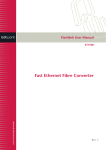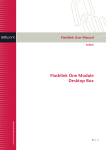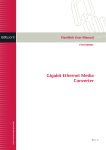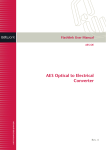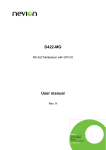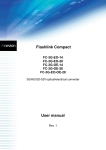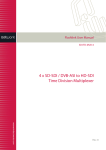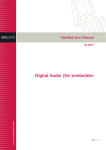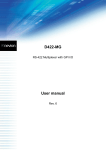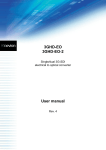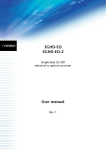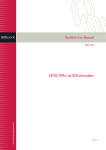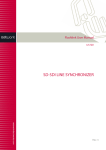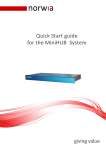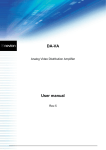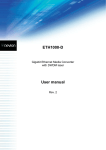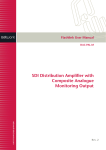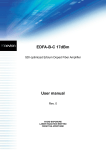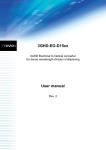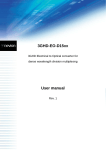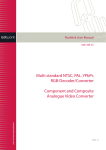Download D422 User Manual
Transcript
Flashlink User Manual D422 RS-422 Data Transceiver Supports CWDM network-electronics.com Rev. 6 D422 Rev. 6 Network Electronics AS 3230 Sandefjord, Norway Phone: +47 33 48 99 99 Fax: +47 33 48 99 98 e-mail: [email protected] www.network-electronics.com Direct Service Phone: +47 90 60 99 99 Revision history The latest version is always available in pdf-format on our web site: http://www.network-electronics.com/ Current revision of this document is the uppermost in the table below. Revision Replaces Date Change Description 6 5 2008-07-24 Added Declaration of Conformity. 5 4 2007-10-24 New front page and removed old logo. 4 3 2007-10-05 Added Materials Declaration and EFUP 3 2 06.02.06 Updated CWDM laser options. 2 1 13.12.05 Added text in table (Chapter 4.2). 1 0 26.11.02 Added CWDM information 0 A 01.11.01 Final first release. 04.09.01 Preliminary version A 2 D422 Rev. 6 Index 1. General......................................................................................................................................................4 2. Specifications............................................................................................................................................5 3. Connector module....................................................................................................................................6 3.1 Mounting the connector module. .........................................................................................................6 3.2 Connector Pin Assignments.................................................................................................................7 3.3 Line Termination .................................................................................................................................7 4. Module status ...........................................................................................................................................7 4.1 GPI – Module Status Outputs ..............................................................................................................8 4.2 Front Panel - Status Monitoring .........................................................................................................9 5. Laser safety precautions........................................................................................................................10 General environmental requirements for flashlink® equipment ..........................................................11 Product Warranty .....................................................................................................................................12 Materials declaration and recycling information ...................................................................................13 Materials declaration ................................................................................................................................13 Environmentally-friendly use period.......................................................................................................13 Recycling information ...............................................................................................................................14 EC Declaration of Conformity .................................................................................................................15 3 D422 Rev. 6 1. General Figure 2. D422 – RS-422 Data Transceiver Block Diagram The flashlink D422 module provides an economical solution for transmitting RS-422 data signals via fiber optic cable. A pair of D422 allows bi-directional transmission of RS-422 data for distances over 60km. When access to fiber is limited, D422 can be combined with the flashlink optical multiplexing WDM, CWDM or DWDM products. As stand alone unit, the D422 module utilises 2 fiber strands for bi-directional data transport. Using either 2 fiber strands or optical multiplexing technology guarantees minimum possible latency for applications where timing is crucial. The D422 module is supplied together with the D422-C1 connector module. The optical output is made with a Fabry-Perot laser diode for 1310±40nm or a DFB laser for 1550±40nm and the CWDM wavelengths according to ITU-T G.694 from 1270±6nm up to 1610±6nm. The product is available in the following versions: D422-13T -7.5dBm D422-13T 0 dBm D422-15T 0 dBm D422-C1470 D422-C1490 D422-C1510 D422-C1530 D422-C1550 D422-C1570 D422-C1590 D422-C1610 1310± 40nm -7.5 dBm F-P laser 1310± 40nm 0 dBm F-P laser 1550± 40nm 0 dBm DFB laser CWDM (DFB lasers) D422-C1270 1470± 6nm 0dBm D422-C1290 1490± 6nm 0dBm D422-C1310 1510± 6nm 0dBm D422-C1330 1530± 6nm 0dBm D422-C1350 1550± 6nm 0dBm D422-C1370 1570± 6nm 0dBm D422-C1390 1590± 6nm 0dBm D422-C1410 1610± 6nm 0dBm 1270± 6nm 0dBm 1290± 6nm 0dBm 1310± 6nm 0dBm 1330± 6nm 0dBm 1350± 6nm 0dBm 1370± 6nm 0dBm 1390± 6nm 0dBm 1410± 6nm 0dBm 4 D422 Rev. 6 2. Specifications Data inputs and outputs Signal format: Connector: Bit Rate: Latency: Electrical Voltage: Power: Control: RS-422 RJ-45 DC up to 115.2 kbps 400ns maximum single direction latency including 1m of fiber. Additional latency 5μs/km of fiber. +5V DC 2.4 Watts RS-422 with protocol for use with GYDA System Controller. Control system has access to set-up and module status with BITE (Built-In Test Equipment). Optical Optical Input Sensitivity: Max. input power: Optical wavelengths: Transmission circuit fiber: Return loss: Connector: better than –30dBm -3dBm 1310nm, 1550nm Multi Mode 50/125μm, Single Mode 9/125μm compatible > 26dB SC/UPC, Return Loss better than 40dB Optical Output Transmission circuit fiber: Light source: Optical wavelength (ver. 13T): Optical power: Optical power (option): Optical wavelength (ver. 15T): Single Mode F-P/DFB Laser 1310nm ± 40nm -7.5 dBm 0 dBm 1550nm ± 40nm Optical power (option): Optical wavelength for CWDM: Optical power for CWDM modules: Jitter (UI=unit interval): Connector return loss: Maximum reflected power: Connector: 0 dBm 1270, 1290, 1310, 1330, 1350, 1370, 1390, 1410, 1470, 1490, 1510, 1530, 1550, 1570, 1590 or 1610 ±6nm according to ITU-T G.694.2 0 dBm 0.135 UI max. better than 40 dB typ. 4% SC/UPC 5 D422 Rev. 6 3. Connector module The D422 has a dedicated connector module: D422-C1. This module is mounted at the rear of the subrack. The module is shown in figure 2. To set up a link, two D422 modules must be used. The RS-422 data cable is connected to RS422/E1 on each of the D422 modules. The two modules are connected to the fibres with one fiber from TX on module 1 to RX on module 2, and from RX on module 1 to TX on module 2. The TX UPG connector contains an electrical version of the modulated signal running on the fiber. This connector is used for future upgrade with a flashlink multichannel DWDM system. The connector marked E2 is not in use with the D422 module. Figure 2. Overview of the D422-C1 connector module 3.1 Mounting the connector module. This section only applies if the module is not purchased pre-mounted in a sub-rack. The details of how the connector module is mounted, is found in the user manual for the sub-rack frame FR-2RU-10-2. This manual is also available from our web site: http://www.network-electronics.com/ 6 D422 Rev. 6 3.2 Connector Pin Assignments RS-422 shall be connected to the RS422/E1 connector, positioned as shown in figure 2. The connector is a RJ-45, 8-pin type. RS-422 pin layout: Signal Name RX + Receive Data Positive RX Receive Data Negative TX + Transmit Data Positive TX Transmit Data Negative Pin # Pin 1 Pin 2 Pin 3 Pin 6 Mode Input Input Output Output Figure 3: RS-422 Outlet 3.3 Line Termination At the end of a RS-422 bus, the line must be terminated with a resistor. With RS-422 lines this is typically done at the receiver side with a 120 ohm resistor. The D422 module has a built in 120 ohm resistor at the receiver input terminal. The transmitter output terminal has no line terminating resistors. 4. Module status The status of the module can be monitored in three ways. 1. GYDA System Controller. 2. GPI at the rear of the sub-rack. 3. LED’s at the front of the sub-rack. Of these three, the GPI and the LED’s are mounted on the module itself, whereas the GYDA System Controller is a separate module giving detailed information of the status of the card. The functions of the GPI and the LED’s are described in sections 4.1 and 4.2. The GYDA controller is described in a separate user manual. 7 D422 Rev. 6 4.1 GPI – Module Status Outputs These outputs can be used for wiring up alarms for third party control systems. The GPI outputs are open collector outputs, sinking to ground when an alarm is triggered. The GPI connector is shown in figure 2. Electrical Maximums for GPI outputs Max current: 100mA Max voltage: 30V D422 module GPI pin layout: Signal Name Status General error status for the module. LOS Los Of optical input Signal Laser Fail Laser Fail Alarm Ground 0 volt pin Pin # Pin 1 Pin 2 Pin 3 Pin 8 Mode Open Collector Open Collector Open Collector 0V. Figure 3: GPI Outlet 8 D422 Rev. 6 4.2 Front Panel - Status Monitoring The status of the module can be easily monitored visually by the LED’s at the front of the module. The LED’s are visible through the front panel as shown in figure 4 on the next page. (Text not printed on the front panel). Figure 4. Front panel indicator overview for D422-13T/15T The D422 has 3 LED’s each showing a status corresponding to the GPI pin layout. The position of the different LED’s is shown in figure 4. Diode \ state Status LOS Laser fail Red LED Module is faulty or Laser is turned off by GYDA Loss of signal No optical input signal. Laser is malfunctioning Green LED Module is OK Module power is OK No light Module has no power Optical input signal present Laser is OK 9 D422 Rev. 6 5. Laser safety precautions Guidelines to limit hazards from laser exposure. All the available EO units in the flashlink® range include a laser. Therefore this note on laser safety should be read thoroughly. The lasers emit light at wavelengths around 1310 nm or 1550 nm. This means that the human eye cannot see the beam, and the blink reflex cannot protect the eye. (The human eye can see light between 400 nm to 700 nm). A laser beam can be harmful to the human eye (depending on laser power and exposure time). Therefore: !! BE CAREFUL WHEN CONNECTING / DISCONNECTING FIBER PIGTAILS (ENDS). NEVER LOOK DIRECTLY INTO THE PIGTAIL OF THE LASER/FIBER. NEVER USE MICROSCOPES, MAGNIFYING GLASSES OR EYE LOUPES TO LOOK INTO A FIBER END. USE LASER SAFETY GOGGLES BLOCKING LIGHT AT 1310 nm AND AT 1550 nm Instruments exist to verify light output power: Power meters, IR-cards etc. flashlink® features: All the laser module cards in the flashlink® product range, are Class 1 laser products according to IEC 825-1 1993, and class I according to 21 CFR 1040.10 when used in normal operation. More details can be found in the user manual for the FR-2RU-10-2 frame. Maximum output power*: 5 mW. Operating wavelengths: > 1270 nm. * Max power is for safety analysis only and does not represent device performance. 10 D422 Rev. 6 General environmental requirements for flashlink® equipment 1. The equipment will meet the guaranteed performance specification under the following environmental conditions: • • Operating room temperature range Operating relative humidity range 0°C to 50°C up to 90% (non-condensing) 2. The equipment will operate without damage under the following environmental conditions: • • Temperature range Relative humidity range -10°C to 55°C up to 95% (non-condensing) 11 D422 Rev. 6 Product Warranty The warranty terms and conditions for the product(s) covered by this manual follow the General Sales Conditions by Network Electronics AS. These conditions are available on the company web site of Network Electronics AS: www.network-electronics.com 12 D422 Rev. 6 Materials declaration and recycling information Materials declaration For product sold into China after 1st March 2007, we comply with the “Administrative Measure on the Control of Pollution by Electronic Information Products”. In the first stage of this legislation, content of six hazardous materials has to be declared. The table below shows the required information. Toxic or hazardous substances and elements 組成名稱 Part Name D422 鉛 汞 镉 六价铬 多溴联苯 多溴二苯醚 Lead Mercury Cadmium Hexavalent Polybrominated Polybrominated (Pb) (Hg) (Cd) Chromium biphenyls diphenyl ethers (Cr(VI)) (PBB) (PBDE) X O O O O O O: Indicates that this toxic or hazardous substance contained in all of the homogeneous materials for this part is below the limit requirement in SJ/T11363-2006. X: Indicates that this toxic or hazardous substance contained in at least one of the homogeneous materials used for this part is above the limit requirement in SJ/T11363-2006. Environmentally-friendly use period The manual must include a statement of the “environmentally friendly use period”. This is defined as the period of normal use before any hazardous material is released to the environment. The guidance on how the EFUP is to be calculated is not finalised at the time of writing. See http://www.aeanet.org/GovernmentAffairs/qfLeOpAaZXaMxqGjSFbEidSdPNtpT.pdf for an unofficial translation of the draft guidance. For our own products, Network Electronics has chosen to use the 50 year figure recommended in this draft regulation. Network Electronics suggests the following statement on An “Environmentally Friendly Use Period” (EFUP) setting out normal use: EFUP is the time the product can be used in normal service life without leaking the hazardous materials. We expect the normal use environment to be in an equipment room at controlled temperature range (0ºC - 40ºC) with moderate humidity (< 90%, noncondensing) and clean air, not subject to vibration or shock. Further, a statement on any hazardous material content, for instance, for a product that uses some tin/lead solders: Where a product contains potentially hazardous materials, this is indicated on the product by the appropriate symbol containing the EFUP. The hazardous material content is limited to lead (Pb) in some solders. This is extremely stable in normal use and the EFUP is taken as 50 years, by comparison with the EFUP given for Digital Exchange/Switching Platform in equipment in Appendix A of “General Rule of Environment-Friendly Use Period of Electronic Information Products”. This is indicated by the product marking: 50 It is assumed that while the product is in normal use, any batteries associated with real-time clocks or battery-backed RAM will be replaced at the regular intervals. 13 D422 Rev. 6 The EFUP relates only to the environmental impact of the product in normal use, it does not imply that the product will continue to be supported for 50 years. Recycling information Network Electronics provides assistance to customers and recyclers through our web site http://www.network-electronics.com. Please contact Network Electronics’ Customer Support for assistance with recycling if this site does not show the information you require. Where it is not possible to return the product to Network Electronics or its agents for recycling, the following general information may be of assistance: Before attempting disassembly, ensure the product is completely disconnected from power and signal connections. All major parts are marked or labelled to show their material content. Depending on the date of manufacture, this product may contain lead in solder. Some circuit boards may contain battery-backed memory devices. 14 D422 Rev. 6 EC Declaration of Conformity Network Electronics AS P.B. 1020, N-3204 SANDEFJORD, Norway MANUFACTURER AUTHORISED REPRESENTATIVE (Established within the EEA) Not applicable MODEL NUMBER(S) D422 DESCRIPTION RS-422 Data Transceiver DIRECTIVES this equipment complies with LVD 73/23/EEC EMC 2004/108/EEC HARMONISED STANDARDS applied in order to verify compliance with Directive(s) EN 55103-1:1996 EN 55103-2:1996 TEST REPORTS ISSUED BY Notified/Competent Body Report no: Nemko E08462.00 TECHNICAL CONSTRUCTION FILE NO Not applicable YEAR WHICH THE CE-MARK WAS AFFIXED 2008 TEST AUTHORIZED SIGNATORY MANUFACTURER AUTHORISED REPRESENTATIVE (Established within EEA) Date of Issue 2008-07-24 Place of Issue Not applicable Name Thomas Øhrbom Position Quality Manager (authorised signature) Sandefjord, Norway 15















